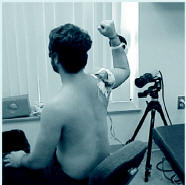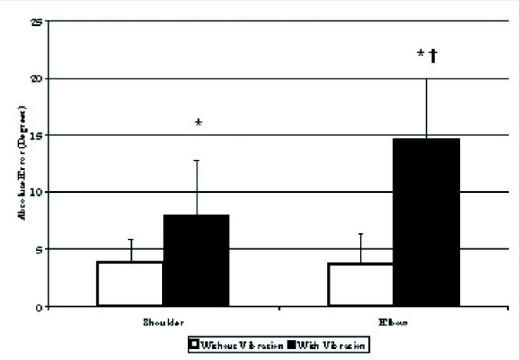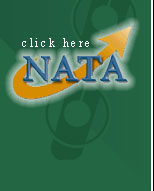|
PRACTICAL
SIGNIFICANCE
The
results
of this
study
suggest
that the
shoulder
and
elbow
are
controlled
by
different
neuromuscular
mechanisms;
and this
information
may
alter
how
rehabilitation
interventions
are
prescribed.
STUDY
BACKGROUND
Previous
studies
have
used a
vibration
stimulus
to
elicit a
re. ex
to
measure
the
afferent
contribution
from
muscle
spindles
to
proprioception.
The
results
of this
past
work
have
frequently
been
generalized
to the
whole
body
without
considering
that
proprioception
mechanisms
may
differ
between
joints.
For
instance,
a recent
study
from our
lab
provided
evidence
that
cryotherapy
does not
decrease
shoulder
joint
position
sense
unlike
that
observed
in the
knee and
ankle.
Based on
these
findings
the
current
study
was
developed
to
concurrently
compare
joint
proprioceptive
mechanisms
being
utilized
at the
elbow
and
shoulder.
OBJECTIVE
The
purpose
of this
study
was to
establish
if
applying
a
mechanical
vibration
stimulus
would
affect
shoulder
and
elbow
joint
proprioception.
DESIGN
AND
SETTING
This
study
instituted
a within
subjects
repeated
measures
design.
The
independent
variables
were 2
joints
(shoulder,
elbow)
and 2
vibration
conditions
(with,
without).
The
dependent
variables
were
variable
error,
absolute,
and
constant
error.
All
testing
was
performed
in the
Athletic
Training/
Sports
Medicine
Laboratory
at the
University
of
Florida.
SUBJECTS
Forty-eight
healthy
subjects
from the
university
population
(ht =
170.9 ±
8.6 cm,
mass =
67.9 ±
11.8 kg,
age =
20.6 ±
1.6
years)
volunteered
for this
study.
MEASUREMENTS
Elbow
and
shoulder
joint
position
sense
was
measured
with and
without
a
vibration
stimulus
(Figure
1). The
difference
between
the
target
angle
and the
repositioned
angle
were
recorded
and
three
error
scores
(absolute
error,
constant
error,
and
variable
error)
were
calculated.
A
separate
repeated
measures
ANOVA
was used
to
analyze
each
error
score at
a
significance
level of
0.05.
RESULTS
A
significant
joint by
treatment
by angle
interaction
was
identified
for
absolute
error
and
constant
error.
The
absolute
error
scores
were
significantly
higher
following
vibration
in the
elbow
[without
3.7° ±
2.6,
with
14.7° ±
5.2, P =
.002]
and the
shoulder
[without
3.8° ±
2.0,
with
8.0° ±
4.8, P >
.001].
(Figure
2.) The
elbow
repositioning
error
was
significantly
higher
than the
shoulder
repositioning
error
following
the
vibration
stimulus
condition.
(Figure
2.)
CONCLUSIONS
The
vibration
stimulus
significantly
affected
the
repositioning
in the
elbow
more
than the
shoulder.
This
suggests
that
clinicians
should
not
assume
proprioceptive
control
and
afferent
inputs
are
equal at
both the
shoulder
and the
elbow
joints.
Future
research
needs to
compare
proprioceptive
testing
and
interventions
between
both
shoulder
and
elbow
joints.
|

|
Figure 1. Setup of shoulder proprioceptive testing with vibration stimulus applied to the posterior shoulder musculature. |
|

|
|
Figure 2. Graph represents diminished joint position sense with vibration on both joints. Significantly greater error was present when the vibration stimulus was applied to the elbow over the shoulder.
* = P < 0.01, indicates vibration causes more error in joint reposition sense for both joints.
† = P < 0.05, indicates vibration to the elbow joint causes more error in joint reposition sense than the shoulder joint.
|
|
Publication
and
Presentation
List:
-
Dover
G,
Conrad
B,
Tillman
M,
Wikstrom
E,
Borsa
P.
Comparison
of
shoulder
and
elbow
joint
position
sense
using
a
vibration
stimulus.
Southeast
Athletic
Trainers’
Association
Clinical
Symposium,
Atlanta,
GA,
2005.
-
Dover
G,
Conrad
B,
Tillman
M,
Wikstrom
E,
Borsa
P.
Comparison
of
shoulder
and
elbow
joint
position
sense
using
a
vibration
stimulus.
Journal
of
Athletic
Training.
2005
(suppl);40:S92.
|
|

Geoff Dover, PhD, ATC, CAT(C)
Principal Investigator
|
|
Geoff Dover earned his Bachelor of Science and diploma in sports injury management at the University of Guelph and Sheridan College in Canada before pursuing his Masters and PhD at the University of Florida. He is currently serving as the director of graduate athletic training at the University of Florida. |
| |
Geoffrey C. Dover, PhD, ATC, CAT(C)
University of Florida
100 Florida Gym PO Box 118205
Gainesville, FL 32611-8205
Phone: (352) 392-0584 *1297
Fax: (352) 392-5262
Email: gdover@hhp.ufl.edu |
|
|
This Grant Information Summary may be downloaded in a 2-page pdf file from http://www.natafoundation.org/pdfs/Dover,Geoff.pdf. |
Back to
September 20, 2006
eBlast
Newsletter
Send e-mail
to johno@nata.org with questions
or
comments
about this web site. |


